Plenty of aquarists want to keep discus – the “severum kings of freshwater aquariums” look stunning.
But the demands they bring set them out of reach of all but the most accomplished experts.
That’s when you can turn your attention to the severum cichlid (Heros spp.).
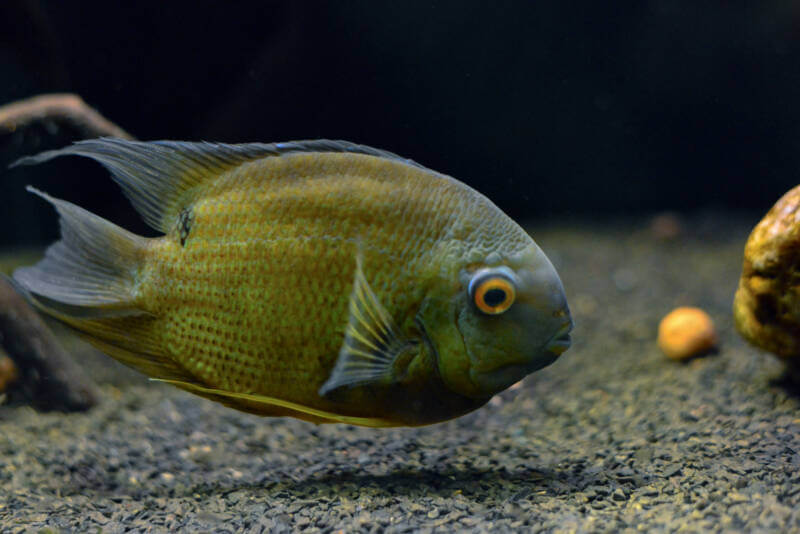
People consider severums the “poor man’s discus.” They come in lower in price, and they also demand less in terms of management.
That checks boxes for plenty of people. Yet you get a similar compressed oval shape AND a variety of colors.
For people enchanted by cichlids, the severum makes a nice compromise.
You don’t need to fret over high levels of aggression (outside of spawning season, anyway), and you can enjoy a decent size from your fish – even if you’re a beginner to the hobby. It’s the best for EVERYONE!
At a Glance
| Minimum tank size: | 45 gal (170 l) for one; 100 gal (379 l) for a pair |
| School size: | okay alone; better if a group of at least 5 |
| Lifespan: | 5-10 years |
| Size: | up to 7 inches (18 cm) |
| Temperature: | 74-84°F (23-29°C) |
| Hardness: | 4-6 dH |
| pH: | 6.0-6.5 |
| Ammonia and nitrite: | 0 ppm |
| Nitrate: | < 30 ppm |
[toc]
In the Wild
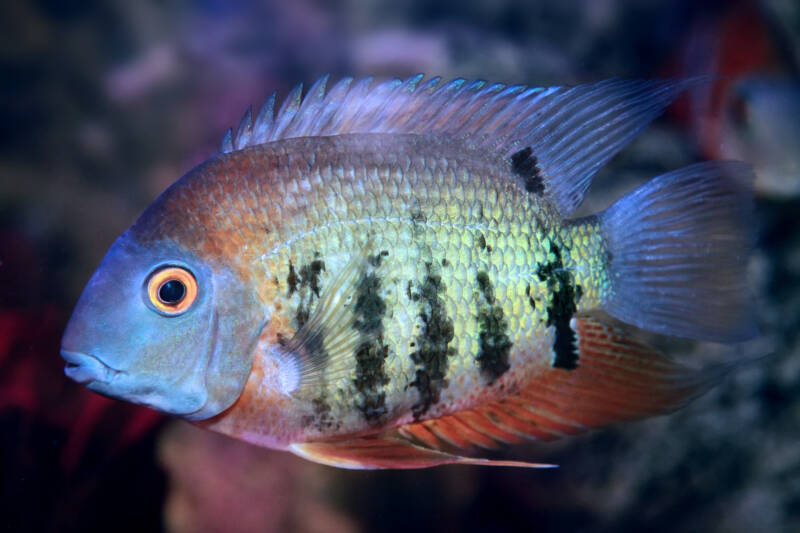
Severum cichlids inhabit the Amazon, Negro, and Orinoco river basins throughout South America.
They spread into rivers, lakes, and flooded forest regions. As long as the waterways contain plenty of vegetation for cover, you’ll come across these flattened fish.
Aquarists recognize the name “severum” (or possibly some of the color variations, which we’ll touch on in a moment), but there are FIVE species that use the common name.
And only two – Heros severus and Heros efasciatus – show up in the aquarium trade.
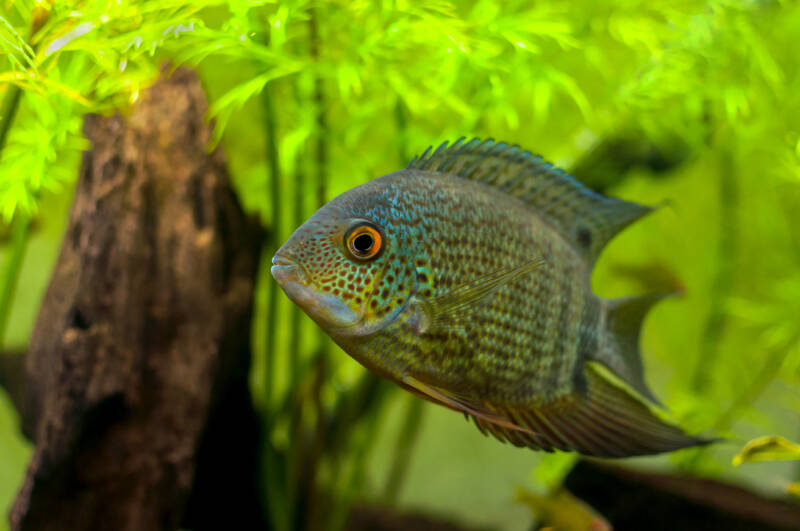
The remaining three species have a similar look and behavior but stick to the wild.
Courtesy of the rich biodiversity of the Amazon (to say nothing of the difficulty of exploring the region), Heros liberifer only put in an appearance in 2015.

That leaves two others:
- Heros notatus
- Heros spurius.
Appearance
All severums share the laterally compressed oval shape that puts people in mind of discus. You also see bands along the sides.
The stripes stand out in the juveniles, fading in adulthood.
And it’s why you see common names like banded cichlid or striped cichlid.
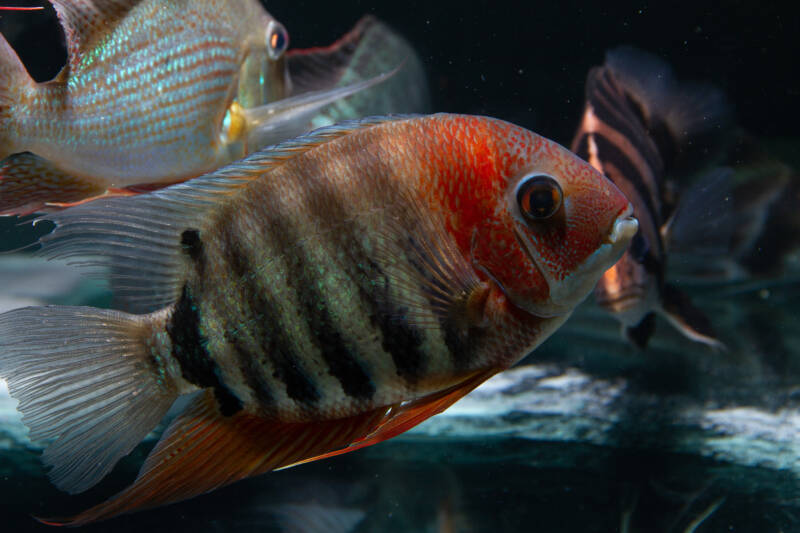
While not AS colorful as discus, severums come in various shades, each with their individual fan clubs.
Four, in particular, seem the most popular with aquarists, showing up frequently in fish stores:
- Gold: Yellow isn’t a shade found in wild severums. However, the golden color stands out in an aquarium. You can find these fish with or without stripes.
- Green: A green shade with tints of yellow along the bottom is the natural color pattern for severum cichlids.
- Red-Spotted: Red-spotted severums come out on top. Starting with a gold base, you find (as you might expect) red dots throughout the body.
- Red Shoulder: These are also known as “rotkeil” or necktie severums. They’re green, except for a vibrant red stripe around the gills and over the top of the shoulder. Breeders select for the pattern in captivity, but you CAN see it in the wild.
Size: A Match For Discus
People love discus fish for their impressive size (and colors, of course).
But that width of 12 inches (30 cm) is one of the tricky parts of managing the species. You need plenty of space to keep them happy and healthy.
In comparison, severum cichlids only reach around 7 inches (18 cm) at full growth. It’s a more manageable size for most aquarists.
However, they do the bulk of their growth in the first two years.
So by the time they’re three years old? You need to have their final tank ready to go.
Lifespan
Without the LONG list of specific needs and wants of their demanding cousins, severum cichlids survive longer.
You’ll see an average lifespan of around five years.
And if you’re willing to put in the effort on their water quality and supply balanced nutrition? You can bump that up to ten!
Behavior
Severum cichlids fall toward the calm side of the temperament scale.
Unlike some of the more aggressive members of the cichlid group, they adopt a peaceful existence.
And if you can manage the space to keep a school? The risk of problems goes down.
That doesn’t mean you CAN’T keep a severum on its own – you can.
However, expect the fish to end up with a higher stress level. As stress increases, so does the risk for disease.
You’ll need to ensure the water quality remains pristine at all times to prevent potential infections.
A shoal of at least five diffuses potential aggression throughout the group.
They swim together and divide their attention between one another – NOT on looking for a tank mate to bully. This can also help you if you decide you want to breed your severums down the road.
Of course, you need to ensure you have room for that many fish.
In close quarters, that famous cichlid mean streak WILL surface. Then you’ll find yourself battling more than spawning problems.
You also need to keep the “nervous disposition” of severum cichlids in mind.
In the wild, they frequent waters with heavy vegetation. As such, they’re not used to sudden movements or light changes around them.
If you don’t watch YOUR behavior near the tank, you’ll spook them.
Tank Setup
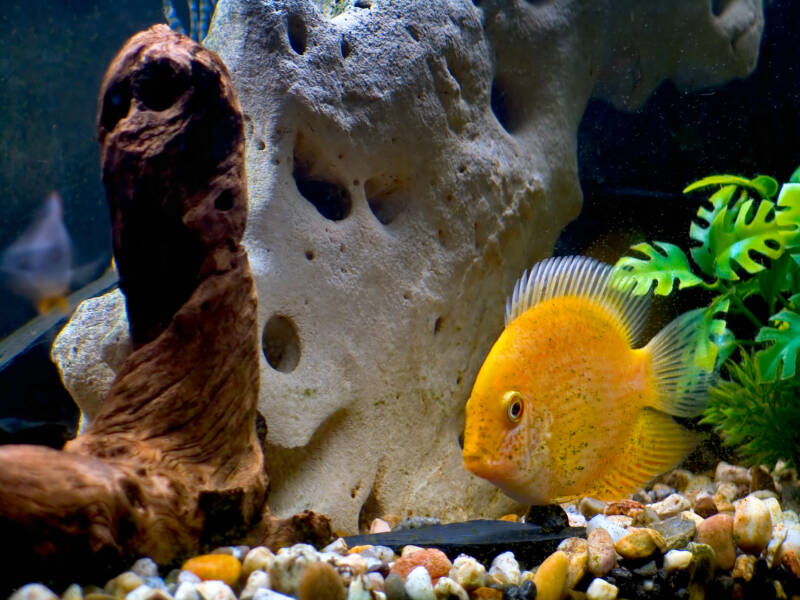
While not the size of discus, severum cichlids aren’t small fish.
They’re also active, with a temperament based on the amount of room to spread their fins. As such, you want to provide as much space as possible to keep your fish happy (and calm).
For one severum, you’ll need at least 45 gallons (170 l).
If you elect to keep a pair (for a breeding situation), you need to increase to 100 gallons (379 l).
And you can run the math from there. The more space you provide, the better your cichlids will do.
Solid omnivores, severum cichlids are still messy fish. Therefore, you’ll want to invest in a reliable filter to keep your tank as clean as possible.
You can increase your water changes, but disturbing the tank over and over won’t help those fishy nerves.
And that’s why you’ll also want a sturdy lid for your tank. Severum’s are NERVOUS.
When startled by movement or light changes, they JUMP. If you don’t have a solid cover, you’ll end up chasing flopping fish around the floor.
Water Parameters
Severum cichlids inhabit the tropical portions of South America.
As such, you’ll want to keep the water temperature a balmy 74-84F (23-29C).
If you plan to work on breeding your severums, you’ll need to make adjustments, but we’ll get to that.
These colorful fish CAN tolerate mildly brackish water.
You don’t want to go beyond a specific gravity of 1.000-1.003, though. That’s because these cichlids prefer soft, acidic water (and salt doesn’t encourage either condition).
Keep the pH level around 6.0-6.5 and the hardness around 4-6 dH.
If you like it, you can also set up a blackwater biotope for your severums.
Decorating the Severum Tank
With a shy side, severum cichlids need places to hide. But they still have a territorial nature and want to defend part of the tank.
You can accomplish both with rockwork and driftwood.
The natural barriers will create “pockets” throughout the tank that form handy territories.
At the same time, the driftwood and natural caves and crevices will provide places to retreat to.
And if you choose flatter pieces of rock for the bottom, your severums will have potential spawning media.
You don’t want to skimp on the plants, either. Don’t forget – in the wild, they swim in rivers and lakes with plenty of vegetation.
They use the greenery as somewhere else to hide, and they chew on it as part of their diet.
Since you’re going to face the need to replace plants due to fish teeth, opt for sturdier varieties.
If you also choose floating species, you’ll help cut down on the overhead lighting (and, thus, shadows) that might frighten your severums:
- Amazon sword
- Anubias
- Cryptocoryne
- Dwarf water lettuce
- Hornwort
- Red root floater
- Water wisteria.
Severum Cichlids in Communities
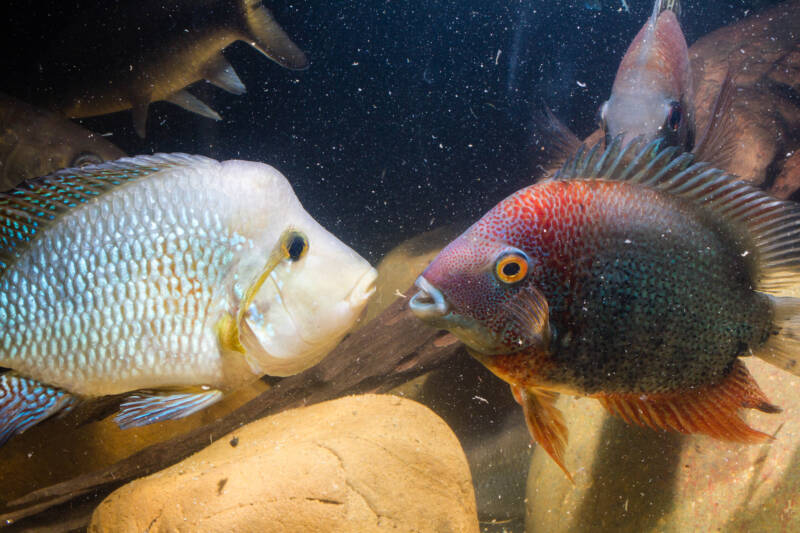
Given their peaceful reputation, it’s no surprise that severum cichlids do well in colorful community tanks.
You need to decorate the tank to provide careful barriers (or they’ll claim the entire aquarium) and provide enough room, but they get along with other fish nicely.
Tank Mates
Surprisingly, you want to look for SMALLER fish species to pair with severums.
They don’t have enough aggression to pair well with larger tank mates. That means considering those that match them – or go down in size:
- Angelfish
- Barbs
- Black skirt tetra
- Blood parrot cichlid
- Blue acara
- Catfish
- Flag cichlid
- Freshwater sharks
- Gouramis
- Loaches
- Pearl cichlid
- Silver dollars.
Incompatible Species
Large, aggressive fish (such as many of the New World cichlid species) present too much of a threat to severums.
While cichlids, severums don’t realize they can defend themselves.
And with those high-stress levels? You’ll end up with a school of ill fish.
You also want to avoid introducing severum cichlids into mixed aquariums.
They find crabs, shrimp, and snails too tempting to resist – as part of the menu.
In no time, they’ll wipe out every invertebrate you add to the collection.
Food and Diet
Most cichlids fall into the omnivore category. But severum cichlids stay squarely in the middle – not leaning to one side or the other.
It makes them easy to feed (again, deviating from the demands of their “king” cousins).
You can use a high-quality commercial diet. For example, pellets or stick-type foods designed for large cichlids work well.
Or you can always make a homemade version if you’d rather skip the preservatives and dyes.
Then you can choose any of their favorite protein sources.
They’ll happily consume frozen, freeze-dried, or live versions of HEALTHY proteins.
This exempts beef heart or liver, which they can’t digest properly. Stick to natural food choices:
- Bloodworms
- Earthworms
- Mealworms.
And, finally, you want to include their dose of vegetables. Severum cichlids enjoy their greens as much as the rest.
You can blanch and offer peas, spinach, or zucchini and watch the school happily down their veggies.
Severums need 4-5 small meals a day. If they only get a large meal once a day, it leads to overfeeding and bloat.
Not to mention it means more waste for you to deal with.
You should also build in a single fast day once a week. It will lead to lean, healthy fish.
Breeding Severum Cichlids: Mouthbrooders or Not?
When you pick up your severum cichlids from the fish store, find out which species you’re getting.
This will let you know what breeding behavior you can expect to see.
Heros severus guards their nest. But Heros efasciatus? They mouth brood the fry.
The breeding process for the two species doesn’t change. But if you don’t know what behavior to watch for, you may panic.
Especially as most first-time severum parents tend to EAT their brood.
You’ll want to know if that persistent pattern is cause for concern or part of the process.
Male or Female?
Luckily, it’s easy to tell male and female severum cichlids apart.
As males mature and approach sexual maturity, they develop a nuchal hump on the forehead. You’ll also see pointed extensions on their anal and dorsal fins.
In contrast, females are smaller in size (even when paired with males that don’t develop that hump).
They have more subtle color, without as much patterning around the head. And you’ll notice a dark spot on the dorsal fin.
Famous Cichlid Aggression
If you want the most success in breeding severum cichlids, you should purchase a school of 6-8 juveniles and introduce them to your tank simultaneously.
This will allow them to mature at the same time and pair off naturally.
You’ll know they’ve selected their mates when the male turns aggressive toward the others in the school.
That’s your cue to separate the pair into their breeding tank. If you don’t, you’re going to cope with that famous cichlid aggression during the spawning process.
For your breeding tank, you want slightly different water conditions.
You still want a warm temperature, but the window’s narrower: 78-80F (25.5-26.6C).
Don’t let the pH go any higher than 6.0 if you want the eggs to develop properly. And keep that water SOFT (5 dH).
Flat surfaces – such as rocks or terracotta pots – in the bottom of the tank work well as spawning media.
If you don’t add anything, odds are your severums will clear away the substrate to reach the glass bottom for the same purpose.
To encourage breeding, increase the amount of live food you offer the pair.
This triggers a spawning cue in their bodies.
You’ll see the male severum cichlid’s scales darken in color. The pair will also clean their chosen spot for the eggs and extend their genital papal.
Severums perform an elaborate courtship ritual that looks frightening.
The male and female “lock lips.” Then you’ll see the two slap their tails back and forth.
Once finished, they’ll spawn. A female severum can lay 100-1,000 eggs depending on her age and size.
Both parents defend their nest site while the eggs develop – assuming they don’t devour them.
If you’re worried, remove the eggs at that point. (This CAN induce the pair to lay additional eggs)
Otherwise, watch to see how they do. The eggs will hatch within 3-5 days.
For Heros severus, the parents move the fry to a second “pit” once they hatch.
They continue to guard them as the fry grow. But they WON’T take the youngsters into their mouths – unless they’re planning to eat them.
Heros efasciatus, on the other hand, DOES mouth brood. Both parents pick up the fry and carry them, only allowing them out to hunt for food.
When the little severums are large enough to swim independently (about six weeks), they stop.
Severum cichlid fry will eat freshly-hatched brine shrimp, Daphnia, microworms, or ground-up commercial foods.
And – usually – parental care can get left to the fish. You just might need to give them a few chances to get things right.
Severum Cichlid Health
Ever heard the phrase, “Stress kills?” For severum cichlids, it’s true.
The constant high cortisol level at work within their bodies puts them at risk of contracting a disease.
And if you’re not paying attention to “nervous” cues, you might miss a brewing problem.
Stressed fish don’t behave normally. They may sit at the surface, gasping for air. This can mean issues with water quality or reduced oxygen levels.
Or you may see your severum swimming in irregular patterns. Either way, you need to investigate your tank.
Cichlids, in general, have healthy appetites. So if your severums refuse to eat, you know you have a problem.
Bloat, swim bladder issues, and head and lateral line erosion (HLLE) can result from poor nutrition. Or you may have other stressors influencing the health of your fish.
If you don’t monitor the “nerves” of your severums, they may contract ich, skin flukes, parasites, or infections.
The suppressed immune system leaves them vulnerable to ANY problem with the tank. And poor water quality? That won’t help the situation, either.
Severum Cichlids: Are They For You?
Compared to their impressive – and expensive – cousins, severum cichlids come in at a reasonable $15-$60, depending on the color pattern you’re looking for.
You don’t need to jump through hoops meeting the exacting demands of a severum. And they’re pleasant additions to any freshwater tank.
However, you still want to aim for high standards to keep those stress hormones as low as possible.
Which Fish is Which?
Figuring out which species of severum you have can get tricky.
Looks alone won’t clue you in. But with some research into behavior, you can puzzle it out. Then you can set up your “poor man’s discus” in all of their glory.
Do you have a tank with severum cichlids? Which species do you keep?
What’s the biggest stressor you’ve needed to battle?
Let us know your questions and stories here!
